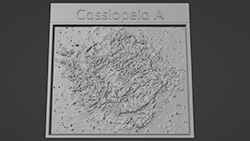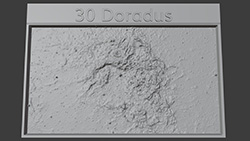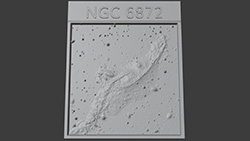CXC Home | Search | Help | Image Use Policy | Latest Images | Privacy | Accessibility | Glossary | Q&A
1
X-ray, Optical, & Infrared ImagesSonification Credit: NASA/CXC/SAO/K.Arcand, SYSTEM Sounds (M. Russo, A. Santaguida)
Sonifications of three images have been released to mark the 25th anniversary of Chandra’s “First Light” image. For Cassiopeia A, which was one of the first objects observed by Chandra, X-ray data from Chandra and infrared data from Webb have been translated into sounds, along with some Hubble data. The second image in the sonification trio, 30 Doradus, also contains Chandra and Webb data. NGC 6872 contains data from Chandra as well as an optical image from Hubble. Each of these datasets have been mapped to notes and sounds based on properties observed by these telescopes. [Listen to the sonifications here].
2
3D Printable Files: Cassiopeia A (3D Print Credit: NASA/CXC/A. Jubett, using software by Tactile Universe/N. Bonne & C. Krawczyk & Blender)
This tactile plate features a physical relief map of Cassiopeia A based on the intensity of X-ray light from Chandra, Infrared light from Webb and Spitzer, and Optical light from Hubble. The resulting tactile plate of Cassiopeia A resembles a disk of electric light with clouds and streaks. An area near the center of the remnant resembles a somewhat circular region of lightning. X-rays from Chandra reveal hot gas, mostly from supernova debris from the destroyed star, and include elements like silicon and iron. X-rays are also present as thin arcs in the outer regions of the remnant.
Data from Webb highlights infrared emission from dust that is warmed up because it is embedded in the hot gas detected by Chandra, and from much cooler supernova debris. Hubble data shows a multitude of stars that dot the field of view.
Data from Webb highlights infrared emission from dust that is warmed up because it is embedded in the hot gas detected by Chandra, and from much cooler supernova debris. Hubble data shows a multitude of stars that dot the field of view.
3D Printable Files: 30 Doradus / Tarantula Nebula
(3D Print Credit: NASA/CXC/A. Jubett, using software by Tactile Universe/N. Bonne & C. Krawczyk & Blender)
(3D Print Credit: NASA/CXC/A. Jubett, using software by Tactile Universe/N. Bonne & C. Krawczyk & Blender)
30 Doradus, otherwise known as the Tarantula Nebula, is a region of active star formation in a neighboring galaxy. This tactile plate depicts 30 Doradus as a physical relief map based on the intensity of X-ray data captured by the Chandra X-ray Observatory and infrared data from the James Webb Space Telescope. The file for this plate can be downloaded and 3D-printed for learners to touch.
In the plate, small specks of light and larger points of stars interact with gas clouds. The brightest and most prominent cloud of X-ray gas appears at the center of the image, roughly shaped like an upward pointing triangle. Darker X-ray clouds can be found near the right and left edges of the image. Thinner patches resembling clouds of roiling fire are the infrared light. The brightest and most prominent infrared cloud appears at the upper left, roughly shaped like a downward pointing triangle. Wispy patches outline the upward pointing bright triangle in the center of the image. Inside this frame is a very bright star with six long, thin, diffraction spikes. Beside it is a cluster of smaller bright specks showing young stars in the nebula.
In the plate, small specks of light and larger points of stars interact with gas clouds. The brightest and most prominent cloud of X-ray gas appears at the center of the image, roughly shaped like an upward pointing triangle. Darker X-ray clouds can be found near the right and left edges of the image. Thinner patches resembling clouds of roiling fire are the infrared light. The brightest and most prominent infrared cloud appears at the upper left, roughly shaped like a downward pointing triangle. Wispy patches outline the upward pointing bright triangle in the center of the image. Inside this frame is a very bright star with six long, thin, diffraction spikes. Beside it is a cluster of smaller bright specks showing young stars in the nebula.
3D Printable Files: NGC 6872
(3D Print Credit: NASA/CXC/A. Jubett, using software by Tactile Universe/N. Bonne & C. Krawczyk & Blender)
(3D Print Credit: NASA/CXC/A. Jubett, using software by Tactile Universe/N. Bonne & C. Krawczyk & Blender)
This tactile plate is a physical relief map based on the intensity of X-ray and optical data. In this composite plate, a large spiral galaxy has some of its superheated gas stolen by a smaller, nearby neighbor. Centered in the frame, NGC 6872 is a large spiral galaxy with two elongated arms that stretch toward our upper right and lower left. Near the raised dot at the heart of the galaxy, a cloud surrounds the arms. This cloud represents hot gas detected by Chandra. Just to the upper left of NGC 6872 is a second spiral galaxy. Its spiraling arms are much smaller, but the raised dot at its core is quite large, suggesting a supermassive black hole. Some of the matter and gas from NGC 6872’s lower arm seems to be floating toward the smaller galaxy, likely pulled toward the supermassive black hole.
Return to: New NASA Sonifications Listen to the Universe's Past (August 26, 2024)
















